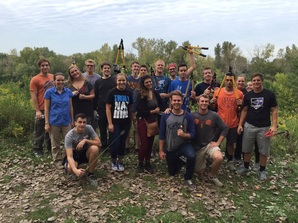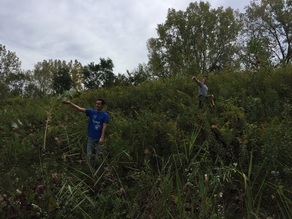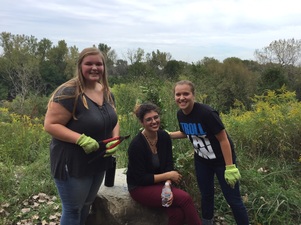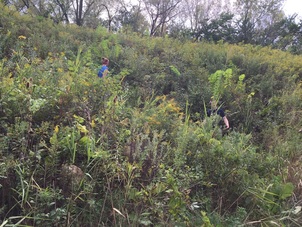|
Here's another guest post on this semester's stewardship efforts.
On September 22, our lab time was spent in the Lake Katherine Nature Center along the Cal Sag River bike path. The topography of the land we were working at was a rising, man-made hill covered in prairie grasses and small trees. When constructing the Cal Sag channel, the developers brought the dirt, top soil, and other parts of the natural habitat up out of the riverbed and onto where it is today, creating a bluff. The prairie land, therefore, is not natural. However, the Lake Katherine environmentalists have worked to create a natural habitat using organisms native to the area. We were tasked with removing all invasive species from the area. These species are not Illinois native plants, but do extremely well in these conditions. Because of this, they take off and intrude on the native species, crowding them out of the ecosystem. Plants like honeysuckle and buckthorn were among the invasive species we were trying to get rid of. By using our hands and clippers, we cleared out the prairie land for a couple hours. It was an important task for us to partake in because it showed the community the service that we as Christians should look to practice daily. It displays that environmental stewardship is important as worshippers of the Creator, and that we are willing to donate our time and effort to help manage the environment. ~Jake DeRuiter
0 Comments
I'm pleased to share a guest post from one of the students in my Environmental Science class.this semester.
Lake Katherine is one of the beauties of God’s creation set just outside of Chicago. Our class worked near the Cal-Sag trail and channel where lovers of nature and boaters come to embrace the fall scenery. Much of its landscape consists of milkweed, New-England aster, compass plant, and other native prairie species. However, many invasive species were also found such as buckthorn and honeysuckle. An invasive species is a plant or animal that is not native to an ecosystem that could cause harm to both humans and native species. Invasive species take up sun and space (growing room) for the native species, essentially killing them. Ecological restoration involves restoring damaged ecosystems with the help of humans. We aided in the ecological restoration of Lake Katherine by pulling the invasive species. As I learned, burning sometimes takes place at Lake Katherine to kill invasive species and allow for only native plants to grow back. In addition, we found many plastic bottles and cans, and properly disposed of them so chemicals from the plastic and aluminum do not affect any animals, plants, or water ways. We were trying to fix what was damaged (invasive species taking over the land and litter) and restore what was originally there (native species). By participating in ecological restoration, we are being stewards to God’s creation and taking care of what He has given us. ~Lauren Siston |
Abbie SchrotenboerI'm a biology professor at Trinity Christian College. I'll be using this page to share interesting stories related to ecology and conservation at Trinity and in the Chicago area (although I might be tempted to expand my geographic focus upon occasion). Archives
December 2020
Categories |




 RSS Feed
RSS Feed
